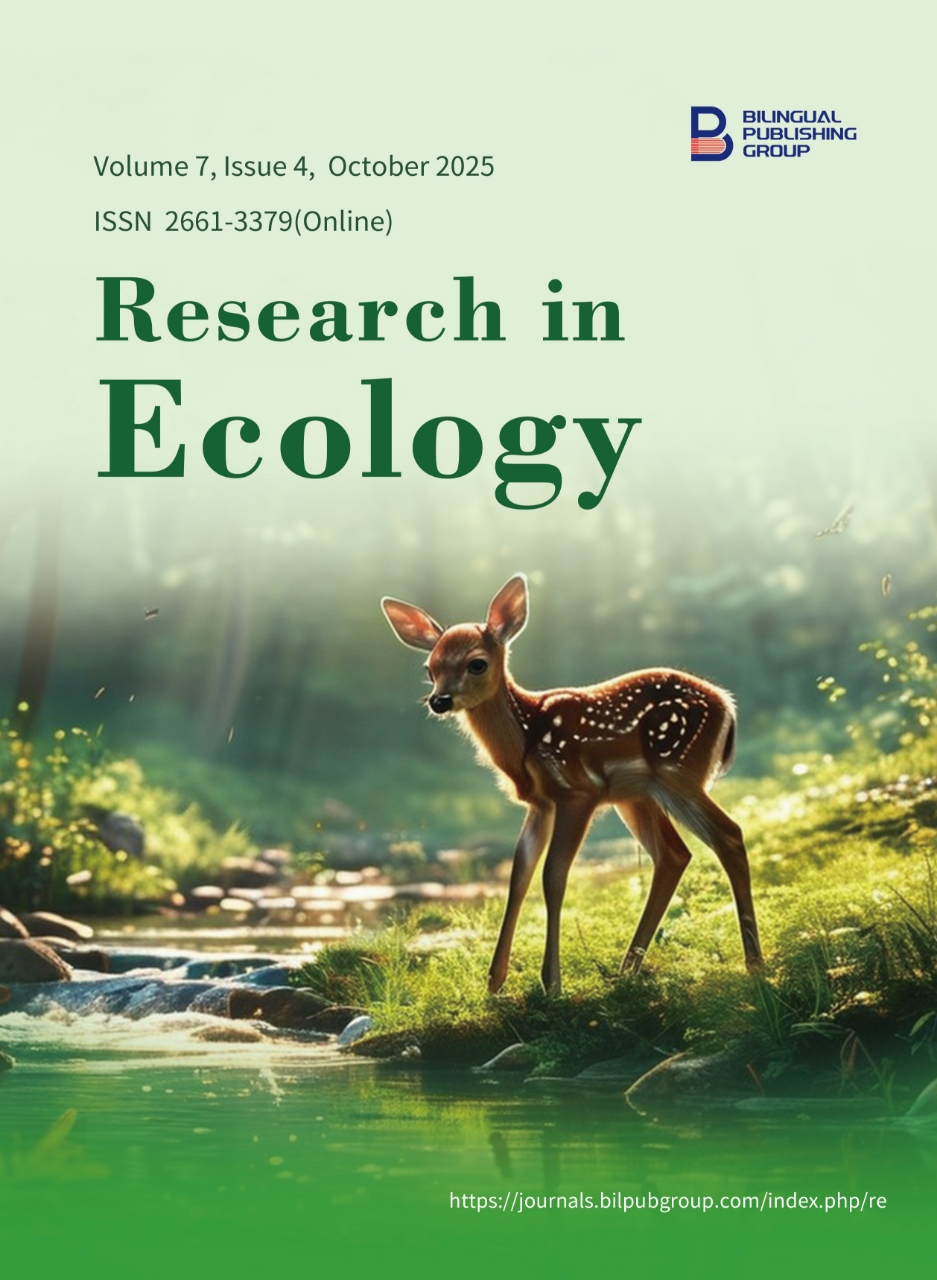
Ecological Assessment of Nano Micronutrient Composites on Growth Dynamics and Yield Performance of Late-Sown Wheat (Triticum aestivum L.)
DOI:
https://doi.org/10.30564/re.v7i4.9640Abstract
Background: The study examines the ecological impact of nano-micronutrient composites on the growth and maturation of late-planted wheat within an agroecological framework. Methods: Experiments conducted using a Randomized Block Design (RBD) with three replications and eight treatment combinations, ensured uniform plant populations prior to treatment applications. Significant variations were observed across multiple growth parameters, including tiller density per square meter and dry matter accumulation at 30, 60, 90, and 120 days after sowing (DAS). Results: Notably, the treatment involving RDF + 20 ppm rGO-Fe + rGO-Zn with two foliar sprays at 45 and 60 DAS (T6) exhibited markedly superior growth performance compared to the control and conventional zinc and iron applications. Maximum grain yield (29.2 q/ha) was achieved in T8 (RDF + 20ppm rGO-Fe + rGO-Zn with two sprays at 45 and 60 DAS) whereas straw yield (50.5 q/ha), biological yield (77.1 q/ha), Harvest Index (38.7 %) and Grain Straw ratio (0.6) were found maximum in RDF + 20ppm rGO-Fe + rGO (Reduced Graphene oxide) − Zn with two sprays at 45 and 60 DAS (T6). Conclusion: The application of reduced graphene oxide (rGO)-based iron and zinc nanoparticles significantly improved nutrient uptake and utilization efficiency, leading to enhanced crop vigor and yield. The study underscores the ecological importance of integrating nanotechnology with nutrient management to sustain a healthy and balanced agroecosystem. This research focuses on sustainable agriculture, nanofertilizers, nutrient use efficiency, and ecological impact, which follows the Q16, Q57, and O13 JEL (Journal of Economic Literature) classification.
Keywords:
Ecology; Sustainability; Nano fertiliser; rGO-Zn; rGO-Fe; Micronutrients; WheatReferences
[1] Gangola, S., Sharma, A., Bhatt, P., et al., 2018. Presence of esterase and laccase in Bacillus subtilis facilitates biodegradation and detoxification of cypermethrin. Scientific Reports. 8, 12755.
[2] Gangola, S., Chaube, S., Bayram, A., et al., 2024. Optimizing microbial strain selection for pyrethroid biodegradation in contaminated environments through a TOPSIS-based decision-making system. Scientific Reports. 14, 14928.
[3] Garg, S., Gairola, K., Punetha, H., et al., 2024. An exploration of the biochemistry of mustard seed meals: A phytochemical and in silico perspective. Foods. 13(24), 4130.
[4] Gangola, S., Sharma, A., Joshi, S., et al., 2022. Novel mechanism and degradation kinetics of pesticides mixture using Bacillus sp. strain 3C in contaminated sites. Pesticide Biochemistry and Physiology. 181, 104996.
[5] Gangola, S., Bhandari, G., Joshi, S., et al., 2023. Esterase and ALDH dehydrogenase-based pesticide degradation by Bacillus brevis 1B from a contaminated environment. Environmental Research. 232, 116332.
[6] Gangola, S., Bhatt, P., Kumar, A.J., et al., 2022. Biotechnological tools to elucidate the mechanism of pesticide degradation in the environment. Chemosphere. 296, 133916. DOI: https://doi.org/10.1016/j.chemosphere.2022.133916
[7] Gangola, S., Joshi, S., Kumar, S., et al., 2021. Differential proteomic analysis under pesticides stress and normal conditions in Bacillus cereus 2D. PLoS One. 16(8), e0253106. DOI: https://doi.org/10.1371/journal.pone.0253106
[8] Gangola, S., Joshi, S., Bhandari, G., et al., 2023. Exploring microbial diversity responses in agricultural fields: A comparative analysis under pesticide stress and non-stress conditions. Frontiers in Microbiology. 14, 1271129. DOI: https://doi.org/10.3389/fmicb.2023.1271129
[9] Bhandari, G., Gangola, S., Bhatt, P., et al., 2024. Potential of the plant rhizomicrobiome for bioremediation of contaminants in agroecosystems. Frontiers in Plant Science. 15, 1397360. DOI: https://doi.org/10.3389/fpls.2024.1397360
[10] Banerjee, S., Roy, P., Nandi, S., et al., 2023. Advanced biotechnological strategies towards the development of crops with enhanced micronutrient content. Plant Growth Regulation. 100, 355–371. DOI: https://doi.org/10.1007/s10725-023-00968-4
[11] Joshi, S., Gangola, S., Jaggi, V., et al., 2023. Functional characterization and molecular fingerprinting of potential phosphate solubilizing bacterial candidates from Shisham rhizosphere. Scientific Reports. 13, 7003. DOI: https://doi.org/10.1038/s41598-023-33217-9
[12] Ghorbanpour, M., Varma, A., et al., 2017. Medicinal plants and environmental challenges. Springer International Publishing: Cham, Switzerland. pp. 177–188. DOI: https://doi.org/10.1007/978-3-319-68717-9
[13] Gomez, K.A., Gomez, A.A., 1984. Statistical Procedures for Agricultural Research. John Wiley & Sons: New York, NY, USA.
[14] Zain, M., Khan, I., Qadri, R.W.K., et al., 2015. Foliar application of micronutrients enhances wheat growth, yield and related attributes. American Journal of Plant Sciences. 6(7), 864–869. DOI: http://dx.doi.org/10.4236/ajps.2015.67094
[15] Gangola, S., Kumar, S., Joshi, S., et al. (eds.), 2023. Advanced Microbial Technology for Sustainable Agriculture and Environment. Elsevier: Amsterdam, Netherlands.
[16] Anjum, S.A., Saleem, M.F., Shahid, M., et al., 2017. Dynamics of soil and foliar applied boron and zinc to improve maize productivity and profitability. Pakistan Journal of Agricultural Research. 30(3). DOI: http://dx.doi.org/10.17582/journal.pjar/2017.30.3.294.302
[17] Miloudi, B., Masmoudi, A., Masmoudi, M.C., 2021. Response of durum wheat (Triticum aestivum L.) to foliar application of micronutrients in salted and calcareous soil. Journal of Fundamental and Applied Sciences. 13(3), 1302–1313. Available from: https://www.ajol.info/index.php/jfas/article/view/248642
[18] Nazir, Q., Wang, X., Hussain, A., et al., 2021. Variation in growth, physiology, yield, and quality of wheat under the application of different zinc coated formulations. Applied Sciences. 11(11), 4797. DOI: https://doi.org/10.3390/app11114797
[19] Varalakshmi, P., Nagarjuna, P., Babu, Y.M., et al., 2021. Effect of zinc nutrition on yield of rice-wheat cropping system and soil properties. Journal of AgriSearch. 8(01).
[20] Bhandari, G., Bhatt, P., Gangola, S., et al., 2022. Degradation mechanism and kinetics of carbendazim using Achromobacter sp. strain GB61. Bioremediation Journal. 26(2), 150–161. DOI: https://doi.org/10.1080/10889868.2021.1911921
[21] Gangola, S., Joshi, S., Goswami, R., et al., 2024. Application of omics approaches to improve bioinoculant performance. In: Microbial Inoculants: Applications for Sustainable Agriculture. Springer Nature: Singapore. pp. 127–143.
[22] Bhatt, P., Gangola, S., Ramola, S., et al., 2023. Insights into the toxicity and biodegradation of fipronil in contaminated environment. Microbiological Research. 266, 127247. DOI: https://doi.org/10.1016/j.micres.2022.127247
[23] Bhatt, P., Sethi, K., Gangola, S., et al., 2022. Modeling and simulation of atrazine biodegradation in bacteria and its effect in other living systems. Journal of Biomolecular Structure and Dynamics. 40(7), 3285–3295. DOI: https://doi.org/10.1080/07391102.2020.1846623
[24] Bhatt, P., Verma, A., Gangola, S., et al., 2021. Microbial glycoconjugates in organic pollutant bioremediation: Recent advances and applications. Microbial Cell Factories. 20, 72. DOI: https://doi.org/10.1186/s12934-021-01556-9
[25] Gangola, S., Joshi, S., Bhandari, G., et al., 2023. Remediation of heavy metals by rhizospheric bacteria and their mechanism of detoxification. In: Advanced Microbial Technology for Sustainable Agriculture and Environment. Academic Press: Cambridge, MA, USA. pp. 31–46.
[26] Gangola, S., Bhatt, P., Joshi, S., et al., 2022. Recent advancements in microbial enzymes and their application in bioremediation of xenobiotic compounds. In: Gupta, V.K., Schmoll, M., Maki, M. (eds.). Industrial Applications of Microbial Enzymes. CRC Press: Boca Raton, FL, USA. pp. 41–57.
[27] Joshi, S., Gangola, S., Bhandari, G., et al., 2023. Rhizospheric bacteria: The key to sustainable heavy metal detoxification strategies. Frontiers in Microbiology. 14, 1229828. DOI: https://doi.org/10.3389/fmicb.2023.1229828
[28] Gangola, S., Bhatt, P., Joshi, S., et al., 2022. Isolation, enrichment, and characterization of fungi for the degradation of organic contaminants. In: Arora, P.K. (ed.). Mycoremediation Protocols. Springer US: New York, NY, USA. pp. 1–11.
[29] Joshi, S., Jaggi, V., Gangola, S., et al., 2021. Contrasting rhizosphere bacterial communities of healthy and wilted Dalbergia sissoo Roxb. forests. Rhizosphere. 17, 100295. DOI: https://doi.org/10.1016/j.rhisph.2020.100295
[30] Pankaj, Negi, G., Gangola, S., et al., 2016. Differential expression and characterization of cypermethrin-degrading potential proteins in Bacillus thuringiensis strain SG4. 3 Biotech. 6, 225. DOI: https://doi.org/10.1007/s13205-016-0541-4
[31] Gangola, S., Joshi, S., Joshi, D., et al., 2022. Advanced molecular technologies for environmental restoration and sustainability. In: Arora, P.K., Kumar, R. (eds.). Bioremediation of Environmental Pollutants: Emerging Trends and Strategies. Springer: Singapore. pp. 385–396.
[32] Gangola, S., Joshi, S., Kumar, S., et al., 2019. Comparative analysis of fungal and bacterial enzymes in biodegradation of xenobiotic compounds. In: Arora, P.K. (ed.). Smart Bioremediation Technologies. Academic Press: London, UK. pp. 169–189.
[33] Gurjar, S.C., Rathore, R.S., Kaushik, R.A., et al., nd. Effect of foliar application of manganese and ferrous on vegetative. Indian Journal of Arid Horticulture. 1(1), 63–66. Available from: https://journals.acspublisher.com/index.php/ijah/article/view/14230
[34] Pawar, P.A., Kohale, V.S., Gawli, K.A., et al., 2019. Effect of foliar application of manganese and ferrous on vegetative growth, fruit yield and quality of mandarin (Citrus reticulata Blanco) cv. Kinnow. Journal of Pharmacognosy and Phytochemistry. 8(6), 434–437. Available from: https://www.phytojournal.com/archives/2019.v8.i6.10045/effect-of-foliar-application-of-manganese-and-ferrous-on-vegetative-growth-fruit-yield-and-quality-of-mandarin-ltemgtcitrus-reticulata-ltemgtblanco-cv-kinnow
[35] Pandey, S., 2022. Effect of foliar application of zinc sulphate, manganese sulphate, iron sulphate and copper sulphate on chilli (Capsicum fructescence L.) [PhD thesis]. Department of Horticulture, Institute of Agricultural Sciences, Banaras Hindu University: Varanasi, Uttar Pradesh. pp. 1–180.
[36] Suresh, V., Ammaan, M., Jagadeeshkanth, R.P., 2018. An overview of micronutrients on growth, yield and quality of citrus. International Journal of Horticulture. 8(14), 163–170.
Downloads
How to Cite
Issue
Article Type
License
Copyright © 2025 Samyak Jain, Vivek Kumar Pathak, Anant Deogaonkar, Piyush Vashistha, Deepshree Kumar, Gumpi Kabak, Kumar Gaurav, Saurabh Gangola, Divya, Pragati Srivastava, Sunil Kumar, Anupama Rawat, Pallavi Bhatt, Rowndel Khwairakpam, Supriya Gupta, Somya Misra, Ashish Gaur, Samiksha Joshi, Rajneesh Bhardwaj

This is an open access article under the Creative Commons Attribution-NonCommercial 4.0 International (CC BY-NC 4.0) License.




 Samyak Jain
Samyak Jain






